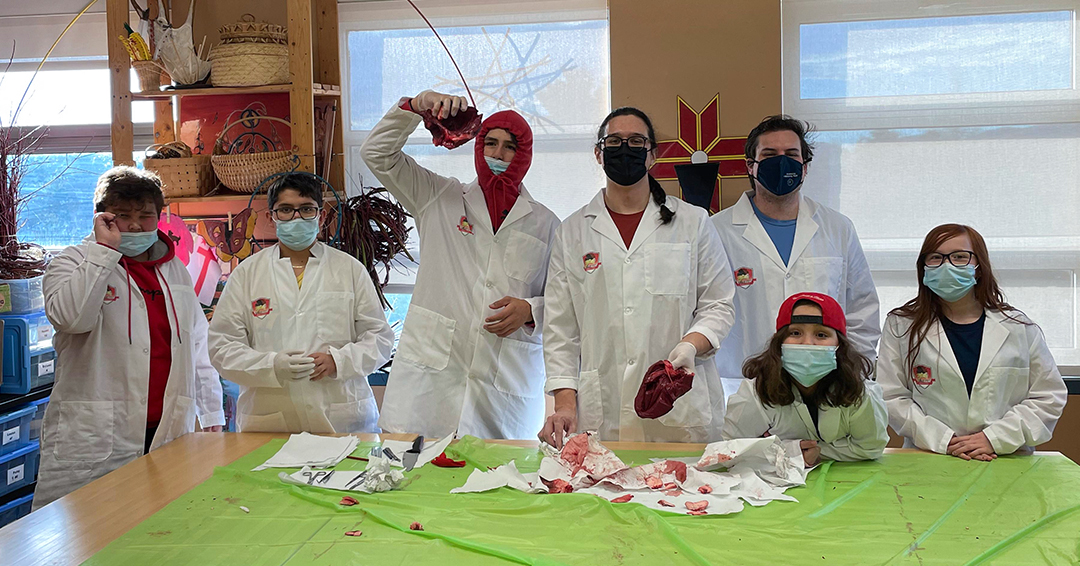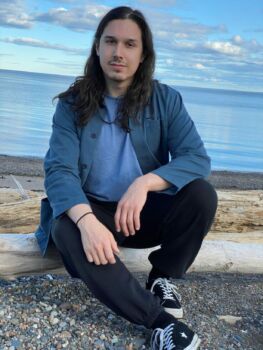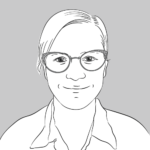
IHPP’s Alex Allard-Gray led a group of Mi’gmaq youth through the dissection of the heart of a moose they hunted themselves
When Alex Allard-Gray, Outreach Administrator for the Indigenous Health Professions Program (IHPP) in the Faculty of Medicine and Health Sciences, and a member of the Listuguj Mi’gmaq First Nation in the Gaspé region of Quebec, was offered an opportunity to combine a health sciences outreach activity with a moose hunt involving kids from his community, he jumped at the chance.

Last fall, he travelled home to join the kids and their teacher for a special lesson in anatomy and physiology using the heart from the moose the group hunted themselves as part of a school project. For Allard-Gray, the activity was a perfect fit with one of IHPP’s missions: community-based learning that connects scientific teaching with traditional values to get Indigenous youth engaged with science.
“The root of all health sciences is a fundamental basis in science itself. This is the whole reason we created the Eagle Spirit Science Futures camp the way we did,” says Allard-Gray, referring to the annual summer science camp for Indigenous teens hosted by the IHPP at McGill. “STEM subjects in general get a bad rap for being very difficult. We hope that by bringing an Indigenous perspective into these very Euro-Western ways of thinking, it will not only make the experience more familiar for students, but that they have an opportunity to excel in it because they’ll connect more with the material.”
It’s hard to imagine an activity more apt than a moose hunt, which most kids from Listuguj would be familiar with. “We’re moose hunters where I’m from – it’s a prominent thing we do in the fall, and it feeds a lot of our community,” explains Allard-Gray. But the hunt is about much more than just food, he adds. The approach of the Mi’gmaq hunters – hunting just what they need and using all the parts of the moose – encompasses concepts of respect and reciprocity for animals and the environment. Adding a scientific teaching element is a natural fit with this world view, says Allard-Gray. “I think this is a really beautiful way of paying tribute to the moose – not only does its hide provide materials to us, not only does its meat provide nutrition to us, but we can even learn from its organs as well.”
Pilot project on pandemic pause
The outreach originally began as a pilot project back in 2019 with middle school kids Allard-Gray’s mother teaches. “I invited the two grade eight classes in our community school to come together and I gave them a human anatomy and physiology lesson,” recounts Allard-Gray. “It was a half-day seminar and then the day after we applied all of that knowledge to dissecting the moose organs. It went off without a hitch and I was hoping to have replicated the activity in other communities.” Unfortunately, the pandemic happened and Allard-Gray had to put that idea temporarily on the shelf.
When the pandemic restrictions were eased, Allard-Gray was contacted by an outdoor education program at another school in Listuguj that uses a land-based learning approach to connect local youth with traditional practices and with nature. The kids, who range from grades five to eight, were going on a moose hunt with their teacher, an experienced hunter. He asked Allard-Gray if he would repeat the heart dissection activity he had done at his mother’s school.
“They hunted this moose during the moose hunting season,” explains Allard-Gray,” and they’ve done a number of things with the hide and they’ve used the meat and created food. They also set aside a heart and a set of lungs for me and froze them.”
Allard-Gray performed the dissection with the kids crowded around. “I would ask them to identify structures or they would point out things and ask about them or make connections from the info I had given them before,” he says. “So they were very much involved in the process.”
Allard-Gray says the feedback from the kids was really positive. “They’re not afraid to handle the hearts and to ask questions and to interact with the materials. The students just felt more familiar with not only the topic, but with the approach as well, which made it more relevant to them. They really enjoyed it.”
Outreach expansion
Allard-Gray says there’s been a lot of interest from other IHPP community partners to hold similar outreach activities. He’s hopeful they can expand the program into more schools in more communities in the coming years. He said doing the activity in the community was really special, and has a real impact. “The fact that it’s being hosted in their home, they can take importance from that,” he says. “They feel like they’re being reflected in that lesson.”
While Allard-Gray mainly focused on anatomy and physiology during the outreach, he did take the opportunity to touch on some everyday health applications. “One of the things that I make sure that the students take away from that lesson as well is how blood pressure functions,” he says. “I bring a sphygmomanometer and a stethoscope, and I teach the students how to take blood pressure – usually using myself as the patient!”
He hopes that by sparking an interest in science in Indigenous youth and also showing them that science is everywhere, including in their own community and traditions, representation of Indigenous people in STEM fields will increase.
“If we can create links between Indigenous ways of thinking and science, we hope that this can transfer to them being successful in their future endeavours in sciences, and, hopefully, health sciences,” says Allard-Gray.
Related:
Indigenous Health Professions Program
Eagle Spirit Science Futures summer camp for Indigenous youth
Listuguj students harvest their first moose through outdoor program (CBC)

